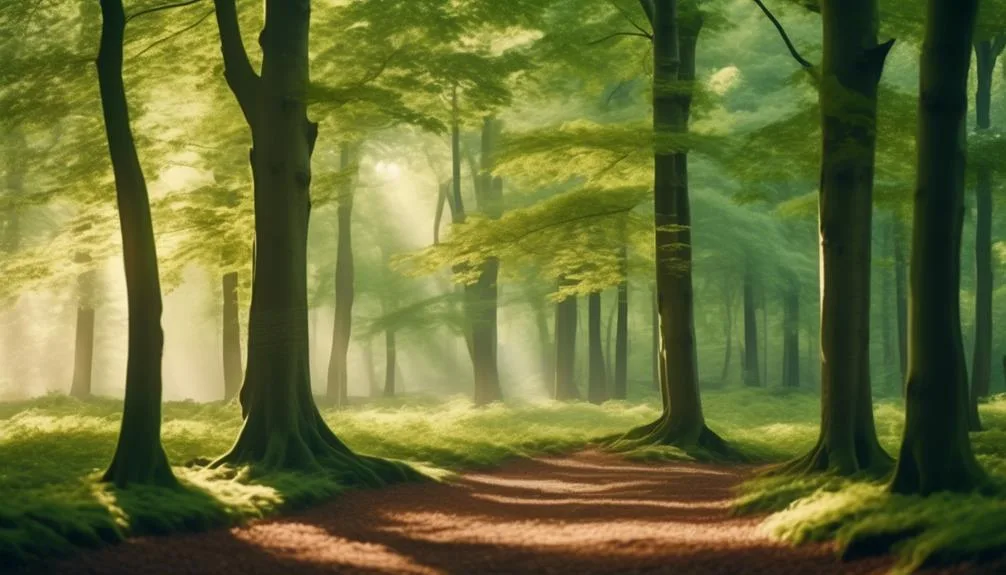Looking to enhance your landscape with the beautiful beech tree? Choosing the right spot for these trees is crucial for their visual impact. Factors like soil quality and sunlight play a key role.
Discover the secrets to creating a stunning setting that will captivate your guests.
Ideal Soil Conditions for Beech Trees
To ensure the optimal growth and health of your beech trees, it's crucial to provide them with well-draining, nutrient-rich soil. When planting beech trees, consider their mature size and space them accordingly, usually about 20-30 feet apart to allow for proper growth and development.
Beech trees have moderate fertilizer needs, and it's important to use a balanced fertilizer to promote healthy foliage and root development. When applying fertilizer, make sure to follow the instructions carefully to avoid over-fertilization, which can be harmful to the trees.
Additionally, beech trees prefer slightly acidic to neutral soil, so it's essential to test the soil pH and make any necessary amendments to create the ideal growing environment for your beech trees. Providing the right soil conditions will set the foundation for thriving, aesthetically pleasing beech trees in your landscape.
Proper Sunlight Requirements for Beech Trees
When ensuring the optimal growth and health of your beech trees, it's essential to consider the proper sunlight requirements for their thriving development. Adequate sunlight exposure is crucial for beech trees to flourish and maintain their iconic beauty.
Here's what you need to know about the sunlight needs of beech trees:
- Sunlight Exposure: Beech trees thrive in partial shade to full sunlight. They require at least 4-6 hours of direct sunlight daily for optimal growth.
- Tree Placement: When planting beech trees, consider their mature size and ensure they've enough space to receive proper sunlight without being overshadowed by larger trees or structures.
- Orientation: Plant beech trees in a location where they can receive morning sunlight, as this helps to dry the foliage and reduce the risk of diseases.
Best Companion Plants for Beech Trees
Opt for companion plants that complement the elegance of your beech trees and enhance the overall aesthetic of your garden or landscape. To create a harmonious and visually appealing environment, consider incorporating pollinator-friendly flowers and shade-tolerant shrubs as companions to your beech trees. These companion plants not only enhance the beauty of the area but also provide additional benefits to the ecosystem. Here are some excellent options for companion plants:
| Pollinator-Friendly Flowers | Shade-Tolerant Shrubs |
|---|---|
| 1. Lavender | 1. Hydrangea |
| 2. Coneflower | 2. Japanese Pieris |
| 3. Black-Eyed Susan | 3. Fothergilla |
| 4. Bee Balm | 4. Oregon Grape |
| 5. Aster | 5. Virginia Sweetspire |
These companion plants not only add visual interest but also attract beneficial insects and provide a diverse and dynamic landscape around your beech trees.
Pruning and Maintenance Tips for Aesthetic Appeal
For an aesthetically appealing landscape, maintaining the graceful form of your beech trees through strategic pruning is essential. When it comes to pruning techniques and shaping methods for your beech trees, there are several key points to keep in mind:
- Timing is crucial: Prune your beech trees during the dormant season to promote healing and reduce stress on the tree.
- Focus on dead or damaged branches: Regularly inspect and prune any dead or damaged branches to enhance the overall appearance and health of the tree.
- Consider the natural form: When shaping your beech trees, aim to enhance their natural beauty rather than forcing an unnatural shape.
Landscaping Ideas With Beech Trees
To enhance the visual appeal of your landscape, consider incorporating beech trees into your overall landscaping design to create a stunning and natural ambiance.
When considering tree placement, remember that beech trees have broad, spreading canopies, so planting them as focal points in open areas can create a dramatic effect.
Their elegant, smooth bark and vibrant green leaves can add a touch of sophistication to any garden design. Try planting a grove of beech trees in a circular pattern to create a secluded and peaceful retreat within your garden.
Their shade tolerance also makes them suitable for creating natural, woodland-inspired garden designs.
Additionally, the coppery autumn leaves of beech trees can add a burst of color to your landscape, making them a versatile and captivating addition to any garden design.
Conclusion
With the right care and attention, your beech trees will blossom, adding timeless beauty to your garden.
By considering soil conditions, sunlight, companions, and pruning, you can create a space that flourishes for years.
How will your beech trees transform your outdoor sanctuary?
Happy planting!

My interest in trees started when I first saw the giant sequoias in Yosemite.
I was a teenager then, and I remember thinking, “I need to learn more about this.”
That moment stuck with me.
A few years later, I went on to study forestry at Michigan Tech.
Since graduating, I’ve worked in a mix of hands-on tree care and community education.
I’ve spent over ten years helping people understand how to plant, maintain, and protect the trees in their neighborhoods.
I don’t see trees as just part of the landscape.
They are living things that make a real difference in our daily lives.
